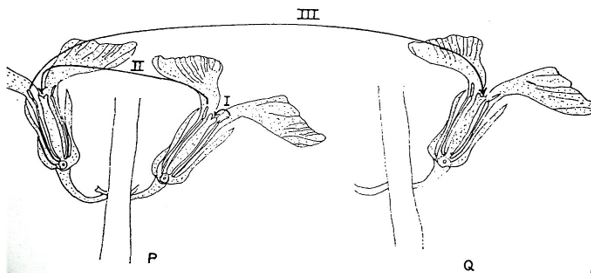Question 4
Plants P and Q are different plants of the same species. Arrows I, II and III show the transfer of pollen grains among the flowers of the plants. Study them and answer questions 4(a) to 4(h).

(a)
(i) What is the term used to describe the transfer of pollen grains in plants? [6 marks]
(ii) Name the type of transfer of pollen grains in I, II and III. [3 marks]
(iii) Explain briefly the reason for each of the answers in 4(a)(ii). [6 marks]
(b)
(i) Name the type of reproduction which involves the transfer of pollen grains.
[1 mark]
(ii) State two reasons for the answer in 4(b)(i). [2 marks]
(c) State three advantages of the transfer of pollen grains illustrated in III over II. [3 marks]
(d) List three agents that could transfer pollen grains among the flowers of plant P. [3 marks]
(e) If plants P and Q are of different species, what would happen to the transfer of pollen grains? [1 mark]
(g) (i) State four characteristics of plants that attract insects for the transfer of pollen grains. [4 marks]
(ii) Name two insects that could be involved in the transfer of pollen grains. [2 marks]
(h) Name two essential parts of a flower. [2 marks]
Observation
Many candidates that lost marks in this question lost them to poor and wrong spellings.
Some candidates could state the types of pollination in I and III only, failing to recognize II as self-pollination which in turn made them lose the mark for the reason.
Many candidates could name the type of reproduction that involves the transfer of pollen grains; but could not express their answers on the reason properly.
Some candidates could also state the characteristics of insect pollinated flowers.
Some candidates could not state the advantage of transfer of pollen grains III has over II. Some candidates could state the agents of transfer of pollen grains and characteristics of flowers that attract insects for the transfer of pollen grains.
Many candidates could also name the insects involved in pollination but lost marks to wrong spellings.
Many of them could not name essential parts of a flower; they were just mentioning random parts of a flower.
The expected answers are:
(a) (i) Term used to describe transfer of pollen grains
Pollination 1 x 1 [1 mark]
Note: spelling must be correct to score.
(ii) Type of transfer of pollen grains
I - Self-pollination;
II - Self-pollination;
III - Cross pollination. 3 x 1 [3 marks]
(iii) Reason for answers in 4 (a)(ii)
I/Self pollination
Transfer of pollen grains from the anther to the stigma; of the same flower. 2 x 1 [2 marks]
II/Self pollination
Transfer of pollen grains from the anther to the stigma; of another flower of the same plant. 2 x 1 [2 marks]
III/Cross pollination
Transfer of pollen grains from the anther of a flower to the stigma of another flower; on another plant of the same species. 2 x 1 [2 marks]
(b) (i) Type of reproduction
Sexual
(ii) Reason for answers in 4 (b)(ii)
The transfer of pollen grains is from the anther to the stigma; male and female gametes are involved. 1 x 1 [1 mark]
(c) Advantages of the transfer of pollen grains illustrated in III over II
- Desirable characteristics of both parents are combined in the offspring;
- There is a chance for better quality offspring/seeds/plants;
- It leads to greater variations among plants;
- May lead to offspring with high yield;
- May lead to offspring with resistance to diseases;
- May lead to offspring with resistance to pests.
Any 3 x 1 [3 marks]
(d) Agents that could transfer pollen grains among flowers of plant P
- Wind;
- Insect/any correctly named insect;
- Birds/any correctly named bird;
- Bats.
Any 3 x 1 [3 marks]
(e) If plants P and Q are of different species
There would be no pollination/fertilization/reproduction. 1 x 1 [1 mark]
(f) Factors that would favour the transfer of pollen grains in III
- Distance between both plants should not be too much/plants should be close;
- If the plant has only one sexual reproductive organ/is unisexual;
- When the stamen/androecium matures first/flower is protandrous;
- When the gynoecium matures first/flower is protogynous;
- Different positions of stigma and anther;
- Dichogamy/maturation of pollen grains and stigma at different times;
- Protandry condition/maturation of pollen grains first;
- Protogyny condition/maturation of female organ first;
- Self sterility/inability of the flower to receive pollen grains from itself.
Any 3 x 1 [3 marks]
(g) (i) Characteristics of plants that attract insects for the transfer of pollen grains
- Brightly coloured petals;
- Pollen grains are sticky;
- Presence of nectar;
- Scented/scent;
- Large/conspicuous petals;
- Sticky stigma. Any 4 x 1 [4 marks]
(ii) Examples of insects that could be involved in the transfer of pollen grains
- Bee(s)
- Butterfly 2 x 1 [2 marks]
Note: spellings must be correct to score.
(h) Essential parts of a flower
- Androecium/stamen/filament and anther
- Gynaecium/ Gynoecium/Carpel/Pistil/Ovary/Style and Stigma together
